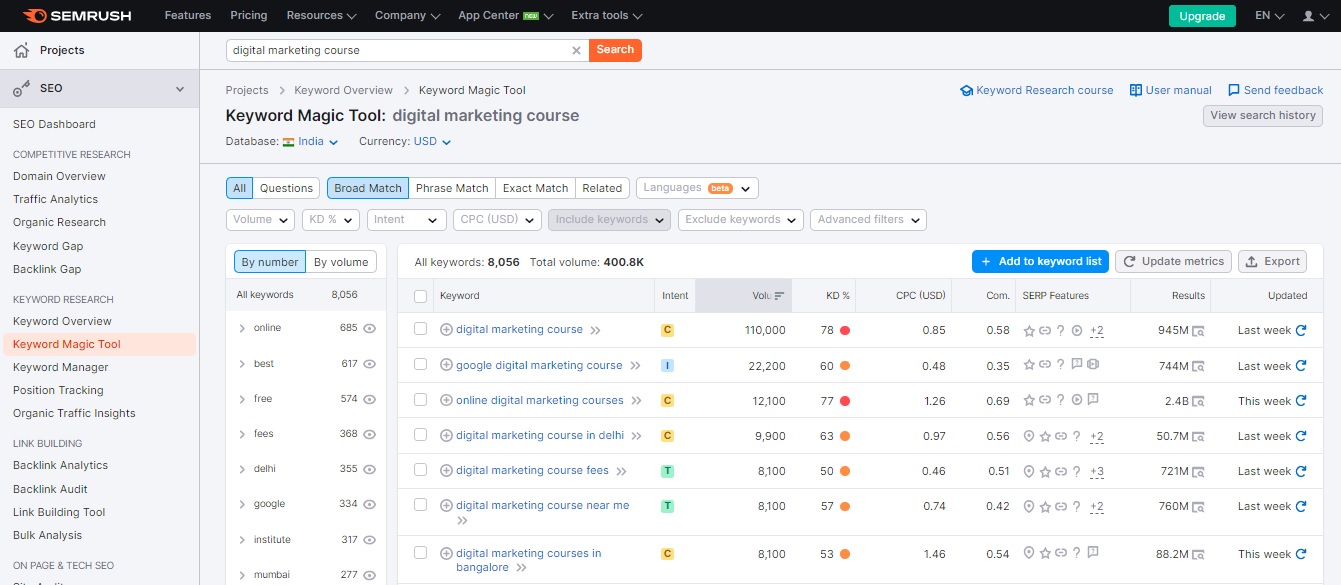Getting Started with Search Engine Marketing (SEM) Basics
Here is a brief introduction to search engine marketing and its basics.
In digital marketing, there are two main concepts related to increasing website traffic. One is organically (SEO) and the other is through paid means (SEM). Search engine marketing largely refers to the paid technique to draw website traffic and even increase brand visibility on search engine results pages (SERPs). Today, this blog will give you a brief insight into search engine marketing.
What is Search Engine Marketing?
Search engine marketing, or SEM, is a type of digital marketing used to gain paid website traffic through ads that appear above organic results on SERPs.
SEM is required for increasing visibility on search engines and for conversions of those at the bottom of the funnel (BOFU).
Best-suited Digital Marketing courses for you
Learn Digital Marketing with these high-rated online courses
Understanding Search Engine Marketing with a Basic Example
Just like SEO or search engine optimization, SEM involves keyword research based on buyer persona too.
And if you use digital marketing tools such as Google Keyword Planner or SEMrush, you will find the cost of keywords to bid for, next to keyword difficulty. These costs determine the SEM strategy.
Suppose a user types the keyword, ‘digital marketing courses’. The SERP shows which is a paid ad first ad then comes the organic results.
These ads in the SERP results are based on the location of the user searching for a query. So whenever a user in India looks for digital marketing courses, there are paid ads from Indian vendors including upGrad and Simplilearn that offer them.
When you go to a tool like SEMrush and type in ‘digital marketing course’, the search volume per month, keyword difficulty, and CPC (cost-per-click) are the three main aspects to consider while creating a paid ad.
We will be elaborating on search engine marketing more below.
How is SEM different from SEO?
Search engine marketing is inorganic. The main difference between the SEO and SEM exists in how websites want to rank on search engine results pages. By following SEO guidelines, a website or page can rank on Google for free.
If the business wants to appear on top of search results as an ad, it has to use paid advertising tactics using Google Ads for Google SERP. To put simply, the business has to pay Google to show the ads.
How is SEM different from PPC?
SEM is also often interchangeably called pay-per-click advertising. While SEO is not a part of SEM, PPC is.
The reason why PPC is considered to be a large part of search engine marketing is that it is paid and inorganic. PPC also differs among platforms and search engines. PPC ads on Google can be used with Google Ads.
What is Ad Auction in Search Engine Marketing?
Auctions are run on Google whenever there is space for SERP, blogs, websites, etc.
For any marketing campaign on Google Ads, you can choose your bidding strategies accordingly. There are different types of bids on Google Ads, including cost-per-click, cost per thousand impressions, cost per action, and cost per view.
When to Bid on CPC?
For driving traffic to your website, you can choose a CPC (cost-per-click) bid. That way, you can spend on the ad only when some user clicks.
When to Bid on vCPM?
Viewable cost per thousand impressions are great when you want to grow an audience who does not know your brand’s name.
When to Bid on CPA?
This type of bidding is done before any action takes place. CPA or cost per action is not only about telling your audience to close a sale, but also as simple as an email sign up.
Key Metrics to Measure in Search Engine Marketing
The key metrics to measure in your search engine marketing campaigns are mentioned below.
Quality Score
It is used for measuring the relevance and expected performance of your ads, keywords, and landing pages. It compares your competitor’s ads and gives you a high or low quality score. When your score is high, there is a higher chance your ad will convert. With a low score, you can think about changing your keywords or your landing page design.
Click-Through Rate
It measures the number of times the ad was clicked against the number of times the ad was seen. A higher CTR is beneficial and gives you a better picture of your ad’s relevancy to your target audience.
Average Position
When you choose a high competition keyword, chances are your competitors are also using the same. Average position is an important metric that tells you at what position on the SERP is your ad showing.

Aquib is a seasoned wordsmith, having penned countless blogs for Indian and international brands. These days, he's all about digital marketing and core management subjects - not to mention his unwavering commitment ... Read Full Bio




